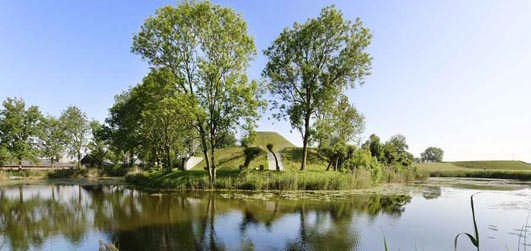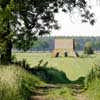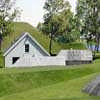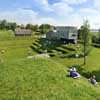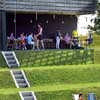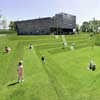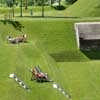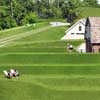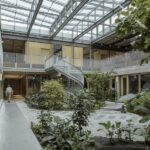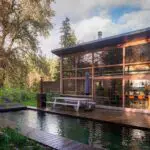Fort Werk aan ‘t Spoel Holland, Culemborg Landscape Design, New Dutch Waterline
Fort Werk aan ‘t Spoel : New Dutch Waterline
Landscape project, Lek dike – Culemborg, Netherlands design by Rietveld Landscape | Atelier de Lyon
15 Aug 2012
Fort Werk aan ‘t Spoel, Netherlands
Design: Rietveld Landscape | Atelier de Lyon
Fort “Werk aan ‘t Spoel” is a national monument dating from 1794. Part of the New Dutch Waterline – a military defense line making use of intentional flooding – it served to protect one of the inundation locks.
The municipality of Culemborg and Foundation Werk aan ‘t Spoel would like to see the derelict fort become a public attraction. In its new function, the fort and a yet to be built fort house should be able to accommodate a wide variety of events and activities initiated by the inhabitants of Culemborg. Rietveld Landscape | Atelier de Lyon have translated these ambitions into a cohesive design in which the former inundation lock is referred to as well.
The design takes its inspiration from the fort’s rich past without historicizing it. It can be understood as an enormous grass sculpture integrating both new and historical elements such as the bunkers, the bombproof buildings and an amphitheatre. The project brings together several local and regional activities; as such, it forms an example of a new type of public domain and has the potential to become one of the most important attractions of the New Dutch Waterline.
Fort Werk aan ‘t Spoel – Information
Client: municipality of Culemborg
Designers: Rietveld Landscape | Atelier de Lyon in collaboration with Anouk Vogel
Architect Fort house: MONK
Military historian: Douwe Koen
Location: Lek dike – Culemborg
Status: completion Autumn 2011
Photographer: Rob ‘t Hart
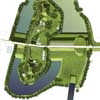
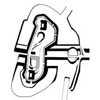
images from Rietveld Landscape
Fort Werk aan ‘t Spoel Project images / information from Rietveld Landscape
Location: Halsteren, The Netherlands
Rietveld Landscape
Studio Profile
Rietveld Landscape was founded by landscape architect Ronald Rietveld after he won the Prix de Rome Architecture 2006. In 2003 he graduated cum laude from the Amsterdam Academy of Architecture.
From its start economist and philosopher Erik Rietveld (Harvard University) and Atelier de Lyon have been part of the studio’s core team. Moreover, according to the specific needs of each project Rietveld Landscape collaborates with external designers and specialists.
Many of our projects deal with large current developments such as floods, vacancy, extreme rainfall and drought, ecology and sustainability, infrastructure, and the changing meaning of public space. Our interventions add a new and understandable layer to the site’s specific history. The relevant scale of the project may vary from a square to a whole region.
Our design and research can be characterized by its specific approach. Sharp analyses followed by clear concepts form the basis of our strategic and sometimes radical interventions. These focus and use the forces of important existing developments and processes to generate a new context and meaning for qualities present. This design method creates new opportunities for landscape, architecture, urban design, the public domain, ecology, recreation, and economic activity.
Rietveld Landscape was curator of the Dutch pavilion for the 12th Venice Architecture Biennale. The office won both Dutch Design Awards in the category Architecture: best interior and best exterior 2011 as well as the Rotterdam Design Prize.
Another Dutch Fort building project on e-architect:
Fort near Hoofddorp
Design: Serge Schoemaker Architects
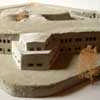
image from architects
Fort Hoofddorp
Dutch architect Serge Schoemaker has revealed his design for the redevelopment of Fort near Hoofddorp (1907). With a redevelopment of the historical site local authorities aspire to make the world heritage monument more known and open to the public.
Another Dutch slice project on e-architect:
Bunker 599
Designers: Atelier de Lyon | Rietveld Landscape
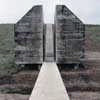
picture from the architects
Dutch Landscape Design
This project lays bare two secrets of the New Dutch Waterline (NDW), a military line of defence in use from 1815 until 1940 protecting the cities of Muiden, Utrecht, Vreeswijk and Gorinchem by means of intentional flooding.
Architecture in The Netherlands
Contemporary Dutch Architecture
Netherlands Architecture Designs – chronological list
Amsterdam Architecture Walking Tours by e-architect
The Oostvaarders building
Design: Drost + van Veen architects
The Oostvaarders
The Animal Refuge Centre
Design: arons en gelauff architecten
Animal Refuge Centre
Borneo Sporenburg : Houses
Design: various architects incl. MVRDV
Borneo Houses
Comments / photos for this Fort Werk aan ‘t Spoel Holland – Culemborg Landscape Design page welcome

